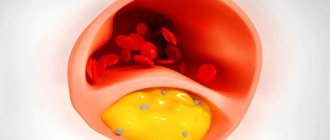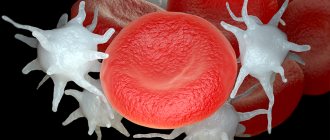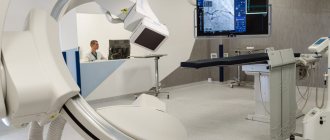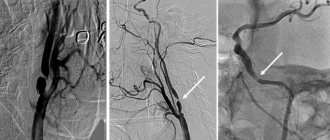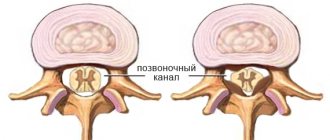General information about the disease
For every thousand men, on average, up to five are affected by myocardial infarction.
For women, the indicator is slightly lower - necrosis of the heart muscle occurs in one in a thousand representatives of the fair sex. The disease most often provokes the appearance of a blood clot in the coronary artery. In addition, among the reasons are:
- arterial spasm;
- arterial dissection;
- entry of foreign bodies into the artery.
In some cases, stressful situations or disproportionate physical activity lead to the disease.
Clinical manifestations
Myocardial infarction can be either the first manifestation of coronary heart disease or occur against the background of long-term angina. The main symptom of myocardial infarction is an attack of unusually intense chest pain, which in patients with angina pectoris does not go away after taking the usual doses of nitroglycerin.
The pain is usually wave-like and can often spread to the left arm, shoulder blade, neck, and teeth. Myocardial infarction occurs both against the background of high blood pressure, and may be accompanied by a decrease in blood pressure with a sharp deterioration in the general condition (severe weakness, cold sweat, nausea). One of the characteristic signs of a heart attack is the fear of death.
Manifestations of a heart attack may differ from the classic picture. There are so-called atypical forms.
Abdominal form
manifested by severe abdominal pain, nausea, vomiting, and digestive disorders.
Asthmatic form
may occur as an attack of bronchial asthma (shortness of breath, difficulty breathing, feeling of lack of air). One of the most insidious forms of myocardial infarction is painless, which occurs without a typical painful attack (angina). The only manifestation of this form may be an unexplained deterioration in general condition, decreased tolerance to physical activity, and weakness.
Low blood pressure after a heart attack
- 1 What to do if you have low blood pressure
- 2 Complications
- 3 Treatment
- 4 Conclusion
According to statistics, it is a heart attack that in most cases causes the death of a patient with pathology of the cardiovascular system. People who have suffered an attack very often turn to doctors with the problem of low blood pressure.
This condition is caused by poor circulation in the body. Thus, after a heart attack, the coronary vessels lose their former elasticity, so the pressure must be constantly monitored, measured regularly and, in case of unforeseen situations, seek qualified medical help.
Read more in this article about the dangers of low blood pressure after a heart attack, what to do, what measures to take first, and what prevention is.
What to do if you have low blood pressure
This condition occurs quite often, therefore, after an attack, doctors often recommend that their patients engage in intense physical activity, limit themselves from negative emotional influences, shocks, and eliminate stress factors.
The first thing to do when experiencing an attack of low blood pressure is to lie down for a while (the body should take a horizontal position), and then drink a mug of sweet coffee or tea. It is recommended to prepare a ginseng decoction.
If such measures do not help, then you need to call an ambulance. In order to prevent such attacks in the future, you need to follow a certain nutritional system.
Patients who have had a myocardial infarction may notice that from time to time their blood pressure drops from normal, especially in the postoperative period.
The reason for this is improper blood circulation, which is caused by narrowing of the coronary arteries, depending on the type of myocardial infarction, as well as loss of vascular elasticity. This condition is called decapitated hypertension.
Read: Nutrition after myocardial infarction
The post-infarction state of a person, even after a series of physiological and drug therapy procedures, cannot be completely identical to the patient’s condition before the heart attack.
Usually, with low pressure, a patient who has had a heart attack experiences persistent general weakness, dizziness, yawning, cold extremities, a slow or rapid heartbeat; such a prolonged condition can lead to a recurrence of the heart attack.
If low blood pressure is regular, then you need to consult your doctor; perhaps medications duplicate their properties and lower your blood pressure.
Read: Can I drink after a heart attack?
Help with low blood pressure
As is known, excessive physical and psychological stress is prohibited for patients who have suffered a myocardial infarction. Low blood pressure may indicate that the patient is not adhering to the physical activity restrictions prescribed by the doctor.
During an attack of low blood pressure, you should take a horizontal position and drink hot tea or coffee with sugar. If your blood sugar is high, you can drink medications containing ginseng extract, so the heart and circulatory system will equalize the pressure to normal.
Read: How long do you live after a heart attack?
Medicine offers several treatment options for those who have experienced myocardial infarction. But effective methods for preventing this disease have not yet been invented.
There are several methods of prevention that show greater or lesser effectiveness, which depends on a number of factors, including the individual characteristics of the human body. Usually it all comes down to a healthy lifestyle and physical activity (jogging, exercise, swimming).
During a heart attack, it is important to exclude physical and psychological stress. If the symptoms described above are present, you should consult a doctor and report your serious condition. The doctor will probably change the prescribed course of therapy.
Low blood pressure is considered to be pressure below 100/60 mm Hg. Art.
The main symptoms of low blood pressure are drowsiness, weakness, and dizziness. To increase it, you can drink a cup of strong tea or coffee.
If the described complaints persist for several days against the background of low blood pressure, that is, excluding other possible causes for the appearance of the above symptoms, such as changes in weather, colds, overwork, it is necessary to consider the issue of adjusting therapy.
You need to understand that the same symptoms can develop in patients whose blood pressure has normalized, for example to 120.80 mm Hg. Art. after long-standing figures of 170-180 mm Hg.
Art. In this case, you must understand that this condition is temporary and some time is needed for the cardiovascular system to adapt to new conditions. Unfortunately, many patients are afraid of such symptoms and believe that this pressure is low for them, as a result they stop taking medications, thereby dooming themselves to the development of complications of hypertension.
Systolic (“upper”) pressure below 60 mm Hg is considered dangerous. With such pressure, urine filtration in the kidneys stops and kidney failure may develop, not to mention a decrease in oxygen supply to the brain and heart; in such cases, an ambulance must be called.
In conclusion, it must be said that especially for young women who do not have sufficient physical activity, low blood pressure is very common. And in such cases, playing sports has a very beneficial effect on this situation. In addition, you can use preparations containing Ginseng, they tone up and can somewhat normalize blood pressure.
How to suspect?
A heart attack with low pressure is accompanied by sternal pain, the duration of which is from a quarter to a third of an hour. The sensations do not go away even if the patient takes nitroglycerin. Many said that they were haunted by the fear of death.
In some cases, the pain seems to be bursting from the inside, while others say that the sensations are squeezing. In any case, the pain is burning and acute. The pain radiates to the jaw, arms, and neck. In some cases, the epigastric part is affected. But sometimes there is no pain at all. This happens in almost a quarter of all cases known to medicine.
What is the pressure during myocardial infarction?
Many patients who have had a myocardial infarction notice a frequent decrease in blood pressure after it. This condition is especially often observed after any interventions on the myocardium.
The main reason that patients experience low blood pressure after a heart attack is impaired blood circulation caused by pathological narrowing of the coronary vessels and loss of their elasticity.
In the language of specialists, such a condition sounds like decapitated hypertension.
Attention! A frequent decrease in blood pressure is fraught with enlargement of the heart, arrhythmic disorders, increased swelling of the legs, and renal failure.
loading.
The twenty-fourth annual meeting of the Scientific Association of Hypertension suggested that low blood pressure increases the risk of heart attack and stroke. The study was based on data examining the positive effects of aggressively lowering LDL cholesterol.
To summarize the above, we can say that during a heart attack:
- at first the pressure is higher than normal;
- on days 2-3 it decreases to levels below normal;
- remains low for a long period (all life).
A repeated sharp increase in pressure may indicate a secondary heart attack.
If you have a blood pressure of 140/90 or higher, then the risk of developing the disease is significantly higher than in people whose blood pressure is within the normal human norm.
If your daily blood pressure is below normal or within normal limits, readings exceeding 140/90 may already indicate a myocardial infarction.
So, what is the pressure during a heart attack? From 140/90 and above.
What complications can occur after stenting of the coronary arteries and heart vessels?
Complications after stenting can occur both immediately after surgery and in the long term. Immediately after implantation of the endoprosthesis, it is possible to develop allergic reactions to medications used during the intervention or over the next few days. Some stents have special coatings that contain substances whose action is aimed at preventing re-narrowing of the vessel. Patients predisposed to allergies may have a reaction to their release into the blood.
When performing stenting of cardiac vessels, complications may include repeated narrowing of the lumen of blood vessels and the formation of blood clots. These are the most common complications, and the attention of medical scientists is currently focused on combating and preventing them. Complications after stenting cannot be excluded, such as the occurrence of perforation of the vessel walls, the development of bleeding and the formation of hematomas at the site of catheter insertion or other parts of the path of passage of the balloon with the stent.
What's first?
In most cases, in the first stages of development, the pressure during a heart attack in women rises to 140, but soon changes to low. The indicators show a sharp decrease on the second or third day of a heart attack, but never reach normal values. The most common diagnosis is pathologically low blood pressure.
If studies have shown a large-focal infarction, the pressure decreases sharply due to the fact that the resistance system in the vascular system is disrupted. In addition, disruptions in the functioning of the cardiohemodynamic system are observed.
How to avoid complications after stenting of heart vessels and coronary arteries
Patients most prone to complications after coronary artery stenting are those with various serious chronic diseases - kidney pathologies, diabetes mellitus, various disorders of hematopoietic and coagulation functions. Factors that increase the risk include old age and poor general condition of the patient’s body at the time of surgery.
In order to prevent the development of complications associated with the above reasons during coronary artery stenting, a thorough examination of the health status of the candidate for angioplasty is carried out even at the stage of preparation for the operation. This includes not only an assessment of the condition of the blood vessels, but also a comprehensive examination with attentive attention to all the patient’s complaints, taking into account all the medications he is taking and their possible reactions with medications administered during and after the operation.
What should you pay attention to?
Pressure during a heart attack is not the only sign that allows you to suspect the disease. In addition, doctors recommend urgently seeking specialized help if you notice:
- noise in ears;
- lack of air;
- rapid heartbeat;
- shortness of breath;
- spots, double vision;
- pulsates in temples;
- face is burning.
But if all the listed symptoms are present, and the pressure is normal, it is too early to calm down. It is likely that peripheral pressure and cardiac output balance blood pressure, however, myocardial infarction exists. Don’t delay seeing a doctor: it’s always better to be overcautious than undersafe.

